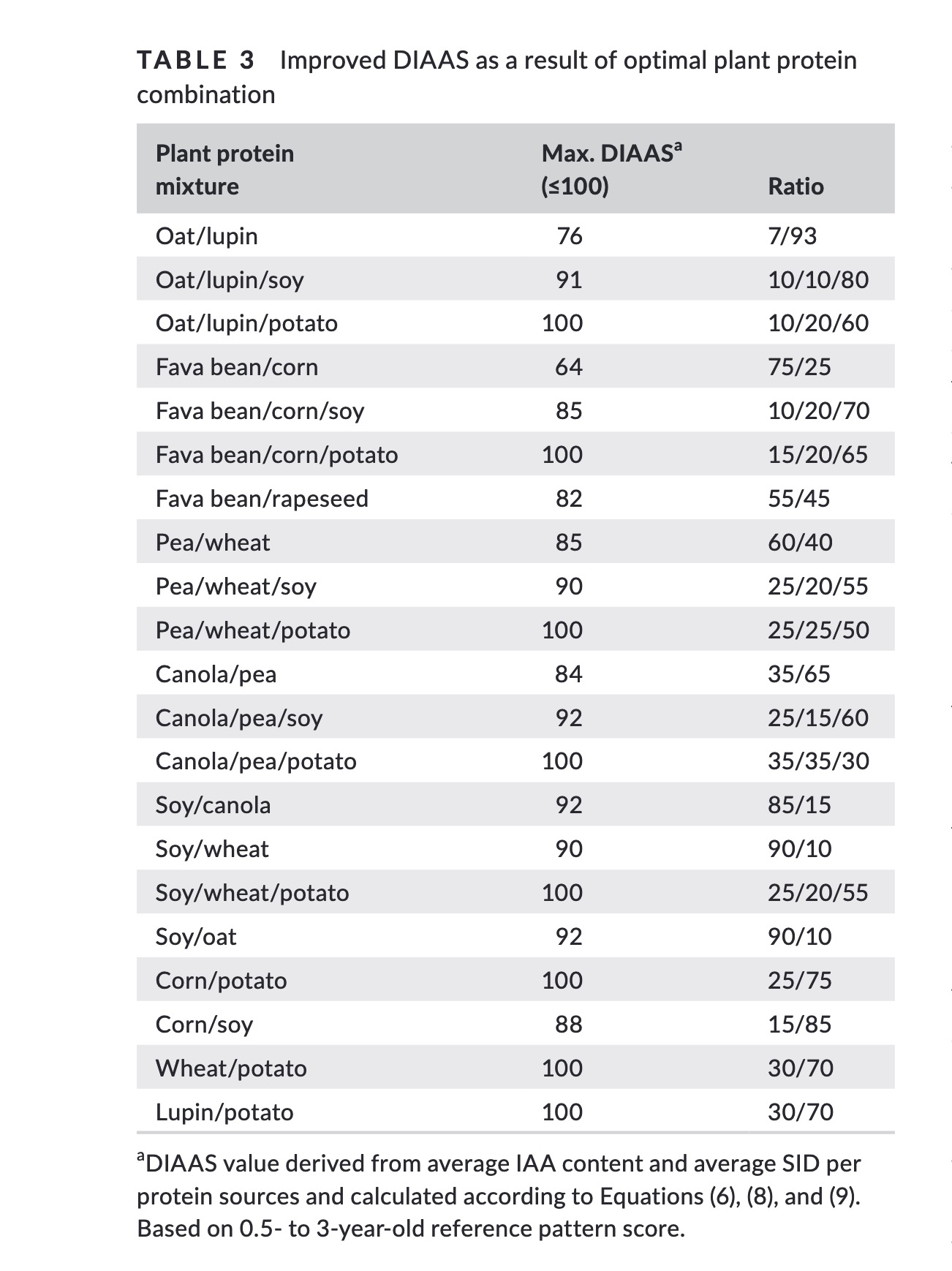cross-posted from: https://hackertalks.com/post/5800192
This is a interesting paper simulating different DIAAS for different plant protein combinations. The higher the DIAAS score, the more bioavailable and complete the protein is.
PBF DIAAS scores found at or above a DIAAS of 100
- Potato
- Oat/Lupin/Potato (10/20/60)
- Fava bean/corn/potato (15/20/65)
- Pea/Wheat/Potato (25/25/50)
- Canola/pea/potato (35/35/30)
- Soy/What/Potato (25/20/55)
- Corn/Potato (25/75)
- Wheat/Potato (30/70)
- Lupin/Potato
Combining PBFs to complete Liebig’s barrel is a novel concept for me, and I thought you might enjoy reading it too.
Indispensable amino acid (IAA) composition and standardized ileal digestibility (SID) of five animal- and 12 plant-based proteins were used to calculate their respective Digestible Indispensable Amino Score (DIAAS) according to the three age categories defined by the Food and Agriculture Organization (FAO). Mean IAA content and mean SID obtained from each protein dataset were subsequently used to simulate optimal nutritional quality of protein mixtures. Datasets revealed considerable variation in DIAAS within the same protein source and among different protein sources. Among the selected protein sources, and based on the 0.5- to 3-year-old reference pattern, pork meat, casein, egg, and potato proteins are classified as excellent quality proteins with an average DIAAS above 100. Whey and soy proteins are classified as high-quality protein with an average DIAAS ≥75. Gelatin, rapeseed, lupin, canola, corn, hemp, fava bean, oat, pea, and rice proteins are classified in the no quality claim category (DIAAS <75). Potato, soy, and pea proteins can complement a broad range of plant proteins, leading to higher DIAAS when supplied in the form of protein mixtures and at specific ratios. Such complementarity highlights the potential to achieve an optimal nutritional efficiency with plant proteins alone.
Direct PDF here
I put my paper reading notes in the original post
Apparently the cross post feature doesn’t work on some apps (i.e. it doesn’t let me add a community specific writeup)
This is a interesting paper simulating different DIAAS for different plant protein combinations. The higher the DIAAS score, the more bioavailable and complete the protein is.
PBF DIAAS scores found at or above a DIAAS of 100
- Potato
- Oat/Lupin/Potato (10/20/60)
- Fava bean/corn/potato (15/20/65)
- Pea/Wheat/Potato (25/25/50)
- Canola/pea/potato (35/35/30)
- Soy/What/Potato (25/20/55)
- Corn/Potato (25/75)
- Wheat/Potato (30/70)
- Lupin/Potato
Combining PBFs to complete Liebig’s barrel is a novel concept for me, and I thought you might enjoy reading it too.

sorry does this mean the combination is more bioavailable?
Strictly talking about plant-based foods, the combination mechanistically would increase the bioavailability score.
It has not been empirically measured in real human beings.
For protein, you need all of the amino acids to be able to use them, so a combination that provides all of the amino acids in the right ratio is considered more bioavailable
One big problem with most protein labels, is its crude protein. It’s just a measure of the nitrogen in the food, which is not an actual measurement of the amino acids. It’s just assumed it’s amino acids. And it doesn’t necessarily mean it’s the right ratio of all of the amino acids humans need in order to use protein. So even if you have lysine, 5,000% of lysine, but no other protein, you won’t be able to use any of that lysine. You need all of them at the same time to use it
